Differential release of chromatin-bound IL-1alpha discriminates between necrotic and apoptotic cell death by the ability to induce sterile inflammation
- PMID: 20133797
- PMCID: PMC2823886
- DOI: 10.1073/pnas.0915018107
Differential release of chromatin-bound IL-1alpha discriminates between necrotic and apoptotic cell death by the ability to induce sterile inflammation
Abstract
IL-1alpha, like IL-1beta, possesses multiple inflammatory and immune properties. However, unlike IL-1beta, the cytokine is present intracellularly in healthy tissues and is not actively secreted. Rather, IL-1alpha translocates to the nucleus and participates in transcription. Here we show that intracellular IL-1alpha is a chromatin-associated cytokine and highly dynamic in the nucleus of living cells. During apoptosis, IL-1alpha concentrates in dense nuclear foci, which markedly reduces its mobile nature. In apoptotic cells, IL-1alpha is retained within the chromatin fraction and is not released along with the cytoplasmic contents. To simulate the in vivo inflammatory response to cells undergoing different mechanisms of death, lysates of cells were embedded in Matrigel plugs and implanted into mice. Lysates from cells undergoing necrosis recruited cells of the myeloid lineage into the Matrigel, whereas lysates of necrotic cells lacking IL-1alpha failed to recruit an infiltrate. In contrast, lysates of cells undergoing apoptotic death were inactive. Cells infiltrating the Matrigel were due to low concentrations (20-50 pg) of the IL-1alpha precursor containing the receptor interacting C-terminal, whereas the N-terminal propiece containing the nuclear localization site failed to do so. When normal keratinocytes were subjected to hypoxia, the constitutive IL-1alpha precursor was released into the supernatant. Thus, after an ischemic event, the IL-1alpha precursor is released by hypoxic cells and incites an inflammatory response by recruiting myeloid cells into the area. Tissues surrounding the necrotic site also sustain damage from the myeloid cells. Nuclear trafficking and differential release during necrosis vs. apoptosis demonstrate that inflammation by IL-1alpha is tightly controlled.
Conflict of interest statement
The authors declare no conflict of interest.
Figures
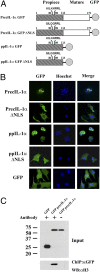
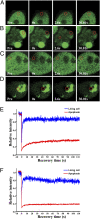
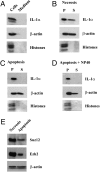
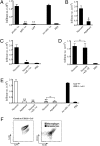
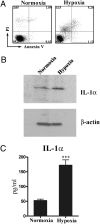
Similar articles
-
IL-1α and IL-1β recruit different myeloid cells and promote different stages of sterile inflammation.J Immunol. 2011 Nov 1;187(9):4835-43. doi: 10.4049/jimmunol.1102048. Epub 2011 Sep 19. J Immunol. 2011. PMID: 21930960
-
Interleukin-1α.Semin Immunol. 2013 Dec 15;25(6):430-8. doi: 10.1016/j.smim.2013.10.005. Epub 2013 Nov 1. Semin Immunol. 2013. PMID: 24183701 Review.
-
Propiece IL-1α facilitates the growth of acute T-lymphocytic leukemia cells through the activation of NF-κB and SP1.Oncotarget. 2017 Feb 28;8(9):15677-15688. doi: 10.18632/oncotarget.14934. Oncotarget. 2017. PMID: 28152513 Free PMC article.
-
Interleukin-1α deficiency attenuates endoplasmic reticulum stress-induced liver damage and CHOP expression in mice.J Hepatol. 2015 Oct;63(4):926-33. doi: 10.1016/j.jhep.2015.05.012. Epub 2015 May 27. J Hepatol. 2015. PMID: 26022690
-
Interleukin 1α: a comprehensive review on the role of IL-1α in the pathogenesis and treatment of autoimmune and inflammatory diseases.Autoimmun Rev. 2021 Mar;20(3):102763. doi: 10.1016/j.autrev.2021.102763. Epub 2021 Jan 20. Autoimmun Rev. 2021. PMID: 33482337 Review.
Cited by
-
Therapeutic Opportunities in Damage-Associated Molecular Pattern-Driven Metabolic Diseases.Antioxid Redox Signal. 2015 Dec 10;23(17):1305-15. doi: 10.1089/ars.2015.6383. Epub 2015 Jul 27. Antioxid Redox Signal. 2015. PMID: 26055926 Free PMC article. Review.
-
Prognostic necroptosis-related gene signature aids immunotherapy in lung adenocarcinoma.Front Genet. 2022 Nov 25;13:1027741. doi: 10.3389/fgene.2022.1027741. eCollection 2022. Front Genet. 2022. PMID: 36506314 Free PMC article.
-
Temporal aspects of the action of ASA404 (vadimezan; DMXAA).Expert Opin Investig Drugs. 2010 Nov;19(11):1413-25. doi: 10.1517/13543784.2010.529128. Expert Opin Investig Drugs. 2010. PMID: 20964495 Free PMC article. Review.
-
Interleukin-1 Inhibitors and Vaccination Including COVID-19 in Inflammatory Rheumatic Diseases: A Nonsystematic Review.Front Immunol. 2022 Jan 27;12:734279. doi: 10.3389/fimmu.2021.734279. eCollection 2021. Front Immunol. 2022. PMID: 35154066 Free PMC article. Review.
-
Schizophrenia and Alarmins.Medicina (Kaunas). 2022 May 24;58(6):694. doi: 10.3390/medicina58060694. Medicina (Kaunas). 2022. PMID: 35743957 Free PMC article. Review.
References
-
- Apte RN, Voronov E. Is interleukin-1 a good or bad ‘guy’ in tumor immunobiology and immunotherapy? Immunol Rev. 2008;222:222–241. - PubMed
-
- Dinarello CA. Immunological and inflammatory functions of the interleukin-1 family. Annu Rev Immunol. 2009;27:519–550. - PubMed
-
- Mosley B, et al. The interleukin-1 receptor binds the human interleukin-1 alpha precursor but not the interleukin-1 beta precursor. J Biol Chem. 1987;262:2941–2944. - PubMed
-
- Buryskova M, Pospisek M, Grothey A, Simmet T, Burysek L. Intracellular interleukin-1alpha functionally interacts with histone acetyltransferase complexes. J Biol Chem. 2004;279:4017–4026. - PubMed
Publication types
MeSH terms
Substances
Grants and funding
LinkOut - more resources
Full Text Sources
Other Literature Sources
Molecular Biology Databases

